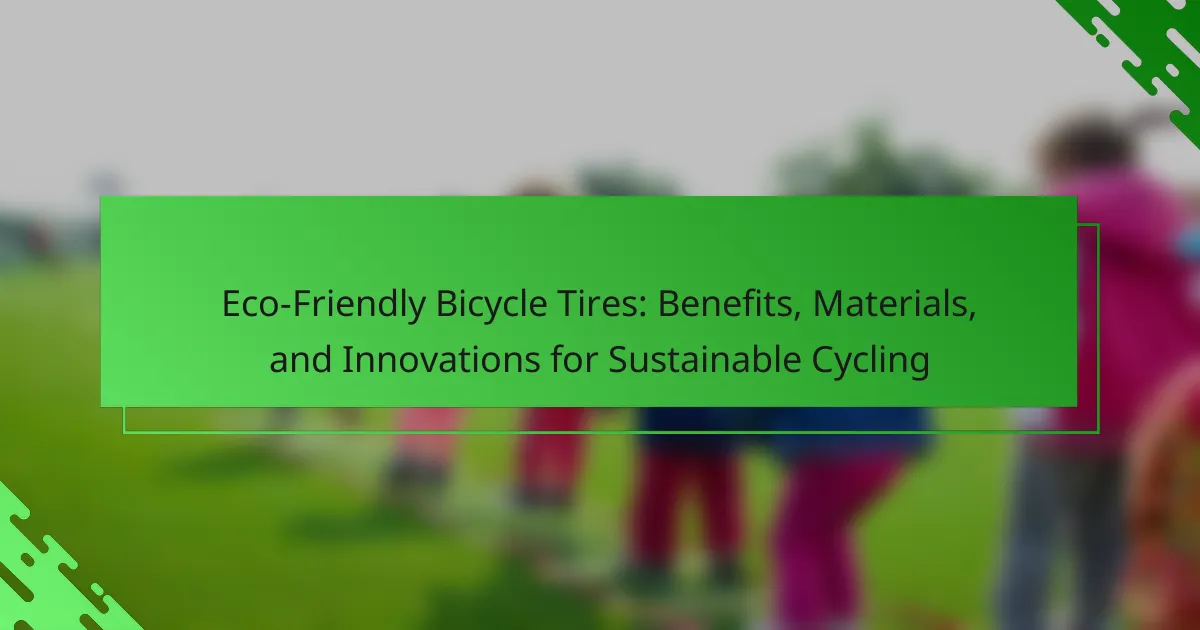Upcycled cycling gear significantly reduces waste and promotes sustainability in the cycling community. This article explores its environmental benefits, creative uses, and examples of leading brands in the industry. Discover how upcycling enhances performance and contributes to a circular economy while showcasing unique designs. Learn about the challenges brands face and emerging trends in this innovative sector.

What are the environmental benefits of upcycled cycling gear?
Upcycled cycling gear offers significant environmental benefits by reducing waste and conserving resources. It minimizes landfill contributions, decreases the demand for new materials, and lowers carbon emissions associated with production. Upcycling transforms discarded items into functional products, promoting a circular economy. This approach encourages creativity and innovation in design, leading to unique cycling gear that stands out.
How does upcycling reduce waste in the cycling industry?
Upcycling reduces waste in the cycling industry by transforming discarded materials into new products. This process minimizes landfill contributions and conserves resources, fostering sustainability. Upcycled cycling gear often features unique designs and lower environmental impact. Brands like Patagonia and Trek exemplify this approach by creating innovative products from recycled materials, showcasing the potential of upcycling to enhance both functionality and style in cycling gear.
What are the carbon footprint implications of using upcycled materials?
Using upcycled materials significantly reduces carbon footprints by minimizing waste and conserving resources. Upcycled cycling gear exemplifies this impact through reduced emissions associated with production. For instance, reusing materials can lower energy consumption by up to 80%. Brands that prioritize upcycling demonstrate innovative sustainability, contributing positively to environmental conservation.
Which sustainable practices are commonly adopted by upcycling brands?
Upcycling brands commonly adopt practices such as sourcing discarded materials, promoting local craftsmanship, and implementing zero-waste production methods. These sustainable practices reduce environmental impact and create unique, eco-friendly products. For example, brands often transform old textiles into new items, minimizing landfill waste.

How can upcycled cycling gear enhance performance?
Upcycled cycling gear can enhance performance by providing durable, lightweight materials and unique designs. These gear items often incorporate advanced technologies and eco-friendly practices, which can lead to improved aerodynamics and comfort. Brands using upcycled materials often report increased customer satisfaction due to the innovative features and sustainability aspects. As a result, cyclists can enjoy better performance while contributing to environmental conservation.
What are the durability advantages of upcycled materials?
Upcycled materials offer enhanced durability advantages, making them ideal for cycling gear. These materials often originate from high-quality sources, ensuring resilience against wear and tear. Upcycled gear can withstand harsh weather conditions and intense usage, prolonging the lifespan of products. Additionally, the unique construction methods used in upcycling often result in superior strength and flexibility, which are essential for performance in cycling.
How does the weight of upcycled gear compare to traditional options?
Upcycled cycling gear typically weighs less than traditional options. This weight reduction stems from the use of lighter materials and innovative designs that prioritize functionality. For instance, brands like Patagonia and REI emphasize lightweight upcycled fabrics, enhancing performance without sacrificing durability. Additionally, the unique attribute of upcycled gear often includes a reduction in waste, contributing to environmental sustainability.
Which features improve rider comfort and experience?
Upcycled cycling gear enhances rider comfort and experience through its innovative designs and sustainable materials. Features such as moisture-wicking fabrics, ergonomic fits, and padded inserts significantly improve comfort during rides. Additionally, reflective elements increase visibility, ensuring safety in low-light conditions. Brands like Patagonia and REI exemplify these benefits by incorporating recycled materials into their cycling apparel, promoting both comfort and environmental responsibility.

What creative uses exist for upcycled cycling gear?
Upcycled cycling gear can be creatively used in various ways, such as fashion accessories, home decor, and functional items. For example, old bike tires can be transformed into stylish bags or belts. Additionally, worn-out jerseys can be repurposed into unique quilts or wall art. This approach not only reduces waste but also promotes sustainability in the cycling community. Each creative use showcases the versatility of upcycled materials while providing practical benefits.
How can old cycling tires be transformed into accessories?
Old cycling tires can be transformed into accessories through creative upcycling techniques. These tires can be repurposed into items like bags, wallets, belts, and home decor. Upcycling cycling gear not only reduces waste but also promotes sustainability. Brands like TerraCycle and Cycle of Good showcase innovative uses of old tires, turning them into unique, eco-friendly products.
What innovative products have emerged from upcycled cycling apparel?
Innovative products from upcycled cycling apparel include bags, jackets, and accessories. Brands like Patagonia and Recycled Cycles create unique items using discarded materials. These products reduce waste and promote sustainability in the cycling community. Upcycled gear often features distinctive designs and enhanced durability, appealing to eco-conscious consumers.
Which DIY projects can cyclists undertake with upcycled materials?
Cyclists can undertake various DIY projects with upcycled materials, such as creating bike storage solutions, making bike accessories, and repurposing old tires. These projects enhance sustainability and creativity.
1. Bike Storage Rack: Use wooden pallets or old shelves to construct a bike storage rack.
2. Panniers: Transform old backpacks or fabric scraps into functional bike panniers.
3. Tire Planters: Cut and shape old tires into unique planters for gardens or patios.
4. Reflective Safety Gear: Repurpose old clothing into reflective vests or accessories for visibility.
5. Water Bottle Holders: Use plastic bottles to create lightweight and durable water bottle holders.
6. Bike Lights: Convert old jars or containers into decorative bike lights with LED strips.
These projects not only save money but also promote eco-friendly practices in cycling.

Which brands are leading the way in upcycled cycling gear?
Several brands are leading in upcycled cycling gear, showcasing innovative designs and sustainable practices. Notable examples include Patagonia, known for its commitment to environmental responsibility, and TREK, which incorporates recycled materials into its products. Other noteworthy brands are Velocio, focusing on high-performance apparel, and ReCycle, which specializes in upcycled accessories. These brands not only promote sustainability but also offer unique, stylish options for cyclists.
What unique approaches do different brands take towards upcycling?
Different brands adopt unique strategies for upcycling cycling gear, focusing on sustainability and creativity. For instance, Patagonia transforms discarded materials into high-performance cycling apparel. Similarly, Tern Bicycles repurposes old bike parts into new accessories, promoting a circular economy. Another example is Velocio, which uses upcycled fabrics to create stylish, eco-friendly cycling clothing. These approaches highlight brand commitment to environmental responsibility while offering innovative products.
How do brand values influence consumer choices in this market?
Brand values significantly influence consumer choices in the upcycled cycling gear market by promoting sustainability and ethical practices. Consumers increasingly prefer brands that align with their values, such as environmental responsibility and social impact. This trend is evident as brands like Patagonia and The North Face emphasize their commitment to reducing waste and supporting local communities. As a result, consumers are more likely to choose products that reflect their personal beliefs, driving demand for innovative, eco-friendly cycling gear.
Which regional brands are gaining popularity in the upcycling movement?
Several regional brands are gaining traction in the upcycling movement, focusing on sustainable cycling gear. Notable examples include Patagonia, known for its recycled materials, and Rapanui, which emphasizes eco-friendly practices. These brands creatively repurpose materials, reducing waste while promoting innovative designs. Additionally, local initiatives often showcase unique attributes, such as community involvement and artisanal craftsmanship, making them stand out in the market.

What challenges do brands face in the upcycling process?
Brands face several challenges in the upcycling process, including sourcing quality materials, ensuring product durability, and maintaining consumer interest. Limited access to reliable suppliers can hinder the availability of upcycled materials. Additionally, brands must navigate the complexities of production processes that differ from traditional manufacturing. Educating consumers about the benefits of upcycled products is crucial for driving demand. Lastly, achieving cost-effectiveness while ensuring sustainability can be a delicate balance for brands.
How do sourcing and material quality impact production?
Sourcing and material quality significantly impact production by determining durability, performance, and sustainability. High-quality upcycled materials enhance product longevity and reduce environmental impact. Brands utilizing superior sourcing practices often achieve better market differentiation and consumer trust. For example, recycled polyester in cycling gear provides both strength and eco-friendliness, appealing to environmentally conscious consumers.
What are the common misconceptions about upcycled cycling gear?
Common misconceptions about upcycled cycling gear include beliefs that it is low quality, unattractive, and less durable. Many assume upcycled products lack innovation or functionality. In reality, upcycled cycling gear often features unique designs and high performance. Additionally, consumers may underestimate the environmental benefits of choosing upcycled materials, which significantly reduce waste and resource consumption.
How can brands overcome consumer skepticism regarding upcycled products?
Brands can overcome consumer skepticism regarding upcycled products by emphasizing transparency, quality, and sustainability. Highlighting the environmental benefits of upcycled cycling gear, such as reduced waste and resource conservation, can build trust. Engaging storytelling about the sourcing and production processes fosters emotional connections. Collaborations with well-known athletes or influencers can also enhance credibility and demonstrate product performance, addressing any doubts consumers may have.

What future trends are emerging in upcycled cycling gear?
Emerging trends in upcycled cycling gear include increased use of innovative materials, customization options, and a focus on sustainability. Brands are integrating technology for improved performance and durability. Collaborative projects with artists and designers are enhancing aesthetic appeal, making upcycled gear more attractive to consumers. As environmental awareness grows, demand for upcycled products is expected to rise, influencing future designs and marketing strategies.
How is technology influencing the upcycling process?
Technology significantly enhances the upcycling process by streamlining design, production, and distribution. Advanced software allows brands to create innovative cycling gear designs from recycled materials, optimizing resource use. For instance, 3D printing technology enables precise manufacturing with minimal waste, promoting sustainability. Additionally, online platforms facilitate community sharing of upcycled products, increasing visibility and encouraging consumer engagement. This tech-driven approach not only reduces environmental impact but also fosters creativity in reimagining cycling gear.
What role does consumer demand play in shaping the future of upcycled gear?
Consumer demand significantly influences the future of upcycled cycling gear by driving innovation and sustainability. As environmentally conscious consumers seek eco-friendly options, brands respond by enhancing their upcycling processes. This shift leads to improved quality, diverse designs, and creative uses of materials. Notably, the demand for unique, customizable products encourages brands to explore new sources of materials, resulting in one-of-a-kind gear that appeals to individual preferences. As a result, the upcycled gear market is expected to grow, reflecting consumers’ values and commitment to sustainability.
Which upcoming brands or products should consumers watch for?
Consumers should watch for innovative brands focusing on upcycled cycling gear, emphasizing sustainability and creativity. Brands like Patagonia and Recycle Your Cycle are leading the way with products made from reclaimed materials. These brands offer unique benefits such as reduced environmental impact and stylish designs. Additionally, emerging brands like Velocio and Bureo are creating buzz with their commitment to upcycling and eco-friendly practices.
What best practices should consumers follow when purchasing upcycled cycling gear?
Consumers should prioritize quality, sustainability, and brand transparency when purchasing upcycled cycling gear. Look for materials that are durable and eco-friendly. Research brands that provide clear information about their sourcing and production processes. Consider the versatility of the gear for various cycling activities. Check for customer reviews to assess performance and comfort. Finally, support brands that promote ethical practices and give back to environmental initiatives.



